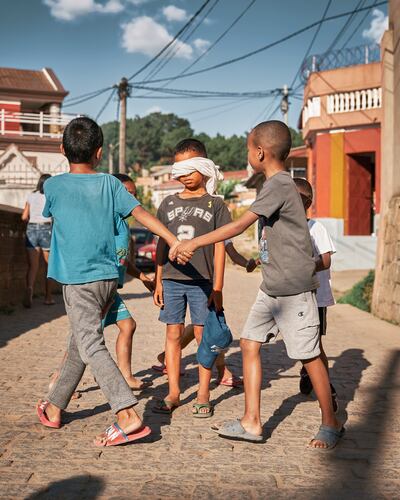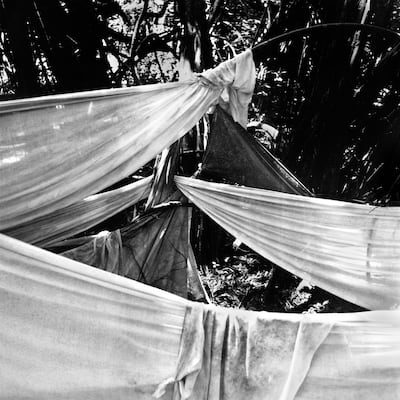The storied textile known as lamba was once omnipresent in Madagascar, woven into the very fabric of society.
It could be decorative or plain. It could be made of silk, cotton, hides or raffia.
It was an item of everyday clothing, but it was also made into more aristocratic pieces worn during ceremonial events, such as weddings.
Mothers used lamba to swaddle their babies or carry them on their backs. In winter, it was a cloak or a shawl. At home, it was a tablecloth and it was also used to drape the dead.
The use of lamba only began to wane as cheaper second-hand clothing from Europe entered the local market in the early 20th century.

A new exhibition at Hakanto Contemporary in Antananarivo highlights these multifaceted aspects of lamba while touching upon the melancholia of its decline.
Lamba Forever Mandrakizay, which runs until November 18, brings together works by more than 20 artists, contrasting them with archival materials.
Curated by Hakanto Contemporary founder Joel Andrianomearisoa, sociologist and cultural mediator Ludonie Velotrasina and artist-curator Rina Ralay-Ranaivo, the exhibition includes pieces ranging from painting and photography to installations, textiles and poetry.
It opens with Tetikasa by Joel Andrianomearisoa, one of Madagascar’s most celebrated artists. The piece is made up of dozens of spools of black thread jutting out from the wall that welcomes visitors to the exhibition.
Arranged equidistantly, the spools cast shadows on the wall similar to those of a sundial, evoking the passage of time and lamba’s connection to life and death.

“Lamba is a piece of a traditional textile that we wear in Madagascar,” says Andrianomearisoa.
“We wear it on our heads and hips. But we are also using the idea of lamba in everything. The idea of the show is that it's designed as an introduction to these infinite names of the idea of the lamba. It’s a polyphonic show.”
Lamba Forever Mandrakizay is an example of how Hakanto Contemporary reaches out to the creative community in Madagascar, encouraging and supporting them to create, even if they do not come from a background in visual arts.
Kevin Ramarohetra’s photography series Doria presents the significance of the lamba in Malagasy culture with concrete visuals.
The photographs are printed on fabric and feature the textile as its predominant subject while depicting its many varied uses.
In one image, it is a blindfold wrapped around the head of a boy in the middle of a game.
In another, it is a pair of umbrellas, bundled and set against the wall by a statue of a female figure also wrapped in lamba.
A third photograph displays a woman looking pensively out of the window. The lamba she wears and wraps her head with is a stunning nod to the many forms and designs it took.

Despite initially planning to print the photographs on regular gloss paper, after conversations with Andrianomearisoa, Ramarohetra says he decided to use textiles instead, as a way of embodying the material.
“I wasn’t convinced at first because I had never tried it," Ramarohetra says. "I was surprised when I saw the results because it was still similar to the original photograph.
"It also brings us to the spirit of the exhibition as we come to use the lamba [in a new way].”
He also displays a triptych of photographs, which pay homage to the use of the lamba across a lifetime.
The first of the works shows a wooden loom with stretched threads. The middle exhibits a noose fashioned from cloth, while the final image depicts a billowing curtain veil that enwraps an empty chair.
“We don’t really know the relationship between Malagasy people and the lamba so I tried to show it in different ways,” Ramarohetra says.
Another piece that touches on memory and absence is Gad Bensalem’s Any Dada. A theatre actor and comedian, Bensalem says he was initially taken aback when Andrianomearisoa approached him to take part.
His work Any Dada comprises several aspects that reflect his background in theatre. One part depicts the work’s title Any Dada, which translates from Malagasy to Dear Father, in the form of a metal installation.
The second, titled Act Two, features a poem displayed on the wall, along with props exhibited around the space, including a sewing machine and a radio.
The poem’s protagonist is Doda, a seller of second-hand clothes whose mother is a seamstress and grandmother a lamba weaver.
Doda is embroiled in the search of a father he has never known, which drives him to despair and causes him to inflict tragedy on those closest to him.
“Absence is the biggest presence you can have in your life. You’re constantly searching for something. That is the story [of the poem], and lamba is in and out of the story,” Bensalem says.

On his decision to work with metal for the installation, he says he wanted to incorporate a reflective medium so that “the public sees their own story within the story of Doda".
Also touching on absence and loss is Nadia Randriamorasata’s 1997.
The artist, who lives in Belgium, spent 13 years away from her native Madagascar, returning to the country this year to take part in a two-month-long residency at Hakanto Contemporary.
Her work at Lamba Forever Mandrakizay is titled after the year of her father’s death.
It constitutes several unfinished pillars made from metal and wood that are positioned in a room with a locked glass door. Much like a memory, they are visible yet physically inaccessible, allusive but incomplete.
“For me, the lamba also evokes death,” Randriamorasata says. “It reminds me of my father’s death and all those Malagasy traditions that have gone with him.”

Randriamorasata began developing the piece as she began to discover Madagascar anew and hoped to get to the root of a hazy memory she had of its bricks and pillars.
“I arrived here wondering where exactly this image and these shapes came from,” she says. “I began to sketch and draw.
"At the same time, this trip here to Madagascar, the fact that I was invited to do an artistic residency, also allowed me to do some introspection in relation to my roots.”
The piece, she says, also pays homage to Malagasy architectural heritage, drawing parallels between land and fabric.
The youngest artist presenting work in Lamba Forever Mandrakizay is Sandra Ramiliarisoa, 23.
She does not come from an artistic background but delivers one of the most searing works in the exhibition: a sprawling textile-based work composed of polyfloss threads, a wool-like material made from recycled medicine bottles.
The work was developed in collaboration with Ndao Hanavao, an eco-humanitarian research and training laboratory comprised of several young Malagasy creatives including Ramiliarisoa.
Titled Ny Hendry No Anarina Fa Ny Adala No Manary Lamba, the work combines traditional weaving patterns with more contemporary approaches in a grid-like fashion.
Even on closer inspection, it is extraordinary to think that the soft and fleecy work is made not from naturally derived material but plastic.

Another work that pushes the boundaries of what materials can create lamba is Sans Titre by Madame Zo. The work is characteristic of the late artist’s approach of using everyday materials to create artworks.
Sans Titre uses VHS cassette tapes to make a chair-like installation.
Madame Zo, who died in 2020, was known for incorporating traditional Malagasy lamba techniques into her work, using material including magnetic tapes and chicken bones, to create colossal woven pieces.
A collaboration between her and Andrianomearisoa is also on display and features a carpet-like work made from car tyres, steel rods, ropes and mesh.
Choreographer Nazaria Tooj’s Ome is a video-based artwork that touches on the cycle of life in the Malagasy tradition.
In the piece, filmed in the open countryside 100km from Antananarivo, a piece of cloth is fixed to stake, fluttering with the wind rushing through the open field.
The lamba is set ablaze by Tooj, turning to ash within seconds, creating a scene of deterioration against the lush mountain range in the backdrop.
He then scrapes the cinders from the stake, his hands blackened.
“Ome means to give, like giving life, or giving life up,” Tooj says. “I emphasised using hands because hands are [always] manipulating, sewing and burning.”

Photographer Christian Sanna’s Lieu De Priere presents a series of life-sized images printed on textile.
One shows a bed seen through a veil. Another depicts lamba tied from branches, offering shade.
Placed a touch from the gallery’s walls, the plastic fabric rustles, giving the sensation that the visuals are being observed in real life, and not as photographs.
“When I started doing photography, I was always frustrated about photography always [being] flat,” Sanna says.
For the series, he contacted an advertising agency to use the plastic fabric often used in its campaigns.
He points to one, which is illuminated by a light positioned behind "like what you see in the metro" – creating an interplay between the photo and its environment.
The photography series is supplemented with poetry, depicted in large block letters on the wall. The poems allude to a relationship, its beginnings and end; as well as the yearning and mourning.

Positioned meticulously between the new works of the exhibition are archival materials, 20th century paintings, photographs and even props, curated in dialogue with the surrounding contemporary works.
Among them is Alphonse Rakotovao’s 1930 painting Merina au Chapeau, which depicts a man draped in lamba, while wearing a straw hat that was modern at the time.
Meanwhile, Gaston Rakotovao’s La Coiffe, a 1933 painting on tissue, shows the back of a woman’s head. She is wearing a lamba as a shawl and looking pensively at something beyond.
Between the archival pieces and the contemporary works, Lamba Forever Mandrakizay offers an intimate look at the significance of the lamba, a cultural touchstone that is often taken for granted.
It shows the variability and mutability of a fabric that seems innocuous at first glance, but that is interwoven with Madagascan history, both personal and societal.
It pays homage to the lamba as it was in its heyday and offers a glimpse at the forms its resurgence might take.
Lamba Forever Mandrakizay is running at Hakanto Contemporary until November 18














